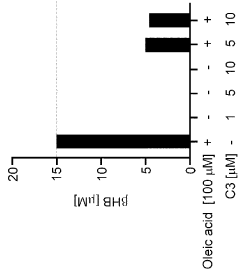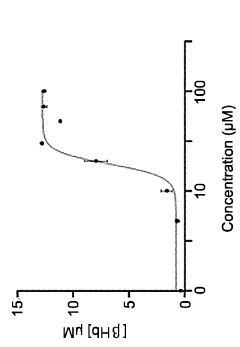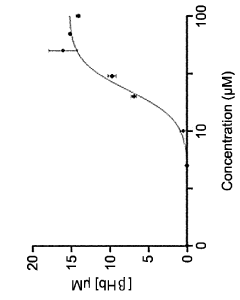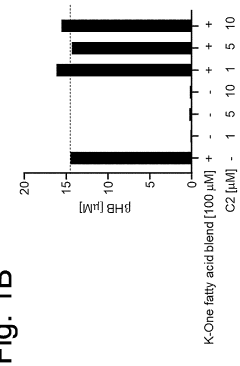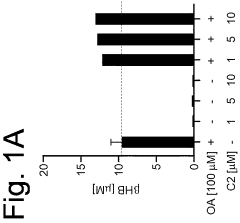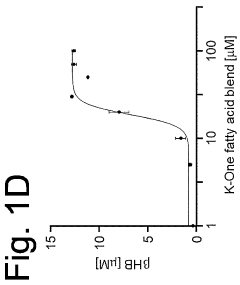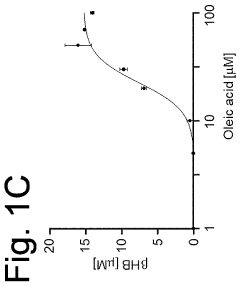Propionic Acid in Health and Nutrition: Emerging Applications
JUL 3, 20259 MIN READ
Generate Your Research Report Instantly with AI Agent
Patsnap Eureka helps you evaluate technical feasibility & market potential.
Propionic Acid Overview
Propionic acid is a short-chain fatty acid naturally produced by gut bacteria during the fermentation of dietary fibers. It plays a crucial role in various physiological processes and has gained significant attention in recent years due to its potential health benefits and emerging applications in nutrition.
Chemically, propionic acid (C3H6O2) is a three-carbon carboxylic acid with a pungent odor. It exists as a colorless liquid at room temperature and is miscible with water. In the human body, propionic acid is primarily produced in the colon by bacterial fermentation of undigested carbohydrates, particularly resistant starch and dietary fiber.
The importance of propionic acid in human health has been increasingly recognized. It serves as an energy source for colonocytes, the cells lining the colon, and plays a role in maintaining gut barrier integrity. Furthermore, propionic acid has been shown to possess anti-inflammatory properties, potentially contributing to the regulation of immune responses in the gut and beyond.
In the context of nutrition, propionic acid has emerged as a promising compound with various potential applications. It has been associated with improved glucose metabolism and insulin sensitivity, suggesting a possible role in the management of metabolic disorders such as type 2 diabetes. Additionally, propionic acid has been linked to appetite regulation and may influence satiety signals, making it a subject of interest in weight management strategies.
The antimicrobial properties of propionic acid have long been recognized, leading to its use as a food preservative. In recent years, there has been growing interest in leveraging these properties for gut health, exploring the potential of propionic acid in modulating the gut microbiome and combating pathogenic bacteria.
Emerging research has also highlighted the potential neuroprotective effects of propionic acid. Studies have suggested that it may influence brain function and behavior, opening up new avenues for investigation in the field of neuroscience and mental health.
As the understanding of propionic acid's role in health and nutrition continues to evolve, researchers are exploring novel ways to harness its benefits. This includes the development of propionic acid-based supplements, functional foods enriched with propionic acid-producing bacteria, and targeted dietary interventions to promote its production in the gut.
Chemically, propionic acid (C3H6O2) is a three-carbon carboxylic acid with a pungent odor. It exists as a colorless liquid at room temperature and is miscible with water. In the human body, propionic acid is primarily produced in the colon by bacterial fermentation of undigested carbohydrates, particularly resistant starch and dietary fiber.
The importance of propionic acid in human health has been increasingly recognized. It serves as an energy source for colonocytes, the cells lining the colon, and plays a role in maintaining gut barrier integrity. Furthermore, propionic acid has been shown to possess anti-inflammatory properties, potentially contributing to the regulation of immune responses in the gut and beyond.
In the context of nutrition, propionic acid has emerged as a promising compound with various potential applications. It has been associated with improved glucose metabolism and insulin sensitivity, suggesting a possible role in the management of metabolic disorders such as type 2 diabetes. Additionally, propionic acid has been linked to appetite regulation and may influence satiety signals, making it a subject of interest in weight management strategies.
The antimicrobial properties of propionic acid have long been recognized, leading to its use as a food preservative. In recent years, there has been growing interest in leveraging these properties for gut health, exploring the potential of propionic acid in modulating the gut microbiome and combating pathogenic bacteria.
Emerging research has also highlighted the potential neuroprotective effects of propionic acid. Studies have suggested that it may influence brain function and behavior, opening up new avenues for investigation in the field of neuroscience and mental health.
As the understanding of propionic acid's role in health and nutrition continues to evolve, researchers are exploring novel ways to harness its benefits. This includes the development of propionic acid-based supplements, functional foods enriched with propionic acid-producing bacteria, and targeted dietary interventions to promote its production in the gut.
Health Market Trends
The global health and nutrition market has been experiencing significant growth and transformation in recent years, driven by increasing consumer awareness of the importance of preventive healthcare and wellness. This trend has created new opportunities for innovative ingredients and products, with propionic acid emerging as a promising component in various health applications.
The functional food and dietary supplement sectors have shown particularly strong growth, with consumers seeking products that offer specific health benefits beyond basic nutrition. Propionic acid, known for its antimicrobial and preservative properties, is gaining attention for its potential role in gut health and metabolic regulation. Market research indicates that products targeting digestive health and immune support have seen double-digit growth rates in recent years, presenting a favorable environment for propionic acid-based solutions.
The sports nutrition market has also expanded rapidly, with a growing focus on performance enhancement and recovery. Propionic acid's potential to improve energy metabolism and reduce lactic acid buildup during exercise positions it well within this segment. Additionally, the increasing popularity of personalized nutrition plans has created demand for specialized ingredients that can be tailored to individual health needs.
In the pharmaceutical and nutraceutical industries, there is a growing interest in natural preservatives and bioactive compounds. Propionic acid's dual functionality as a preservative and potential health-promoting agent aligns well with this trend. The clean label movement has further bolstered the appeal of naturally-derived ingredients like propionic acid, which can be produced through fermentation processes.
The aging population in many developed countries has led to increased demand for products that support healthy aging and manage age-related conditions. Propionic acid's potential benefits for bone health and calcium absorption could make it a valuable ingredient in products targeting this demographic. Moreover, the rise of preventive healthcare approaches has created opportunities for ingredients that support long-term health maintenance.
E-commerce and direct-to-consumer channels have revolutionized the health product market, allowing for more niche and specialized offerings. This shift has enabled smaller, innovative companies to introduce propionic acid-based products directly to health-conscious consumers. The trend towards transparency and traceability in the supply chain has also influenced consumer preferences, favoring ingredients with clear origins and production methods.
As the health and nutrition market continues to evolve, propionic acid stands to benefit from the increasing demand for multifunctional ingredients that can address multiple health concerns simultaneously. Its potential applications in areas such as weight management, cardiovascular health, and cognitive function align well with current market trends and consumer priorities.
The functional food and dietary supplement sectors have shown particularly strong growth, with consumers seeking products that offer specific health benefits beyond basic nutrition. Propionic acid, known for its antimicrobial and preservative properties, is gaining attention for its potential role in gut health and metabolic regulation. Market research indicates that products targeting digestive health and immune support have seen double-digit growth rates in recent years, presenting a favorable environment for propionic acid-based solutions.
The sports nutrition market has also expanded rapidly, with a growing focus on performance enhancement and recovery. Propionic acid's potential to improve energy metabolism and reduce lactic acid buildup during exercise positions it well within this segment. Additionally, the increasing popularity of personalized nutrition plans has created demand for specialized ingredients that can be tailored to individual health needs.
In the pharmaceutical and nutraceutical industries, there is a growing interest in natural preservatives and bioactive compounds. Propionic acid's dual functionality as a preservative and potential health-promoting agent aligns well with this trend. The clean label movement has further bolstered the appeal of naturally-derived ingredients like propionic acid, which can be produced through fermentation processes.
The aging population in many developed countries has led to increased demand for products that support healthy aging and manage age-related conditions. Propionic acid's potential benefits for bone health and calcium absorption could make it a valuable ingredient in products targeting this demographic. Moreover, the rise of preventive healthcare approaches has created opportunities for ingredients that support long-term health maintenance.
E-commerce and direct-to-consumer channels have revolutionized the health product market, allowing for more niche and specialized offerings. This shift has enabled smaller, innovative companies to introduce propionic acid-based products directly to health-conscious consumers. The trend towards transparency and traceability in the supply chain has also influenced consumer preferences, favoring ingredients with clear origins and production methods.
As the health and nutrition market continues to evolve, propionic acid stands to benefit from the increasing demand for multifunctional ingredients that can address multiple health concerns simultaneously. Its potential applications in areas such as weight management, cardiovascular health, and cognitive function align well with current market trends and consumer priorities.
Current Applications
Propionic acid has gained significant attention in recent years for its diverse applications in health and nutrition. Currently, this short-chain fatty acid is utilized across various sectors, demonstrating its versatility and importance in modern health practices.
In the food industry, propionic acid serves as a widely used preservative. Its antimicrobial properties effectively inhibit the growth of mold and bacteria, extending the shelf life of baked goods, cheese, and other perishable food products. This application not only ensures food safety but also reduces food waste, addressing a critical global concern.
The animal feed sector has also embraced propionic acid as a feed preservative. By preventing the growth of harmful microorganisms in animal feed, it helps maintain the nutritional quality of the feed and promotes better animal health. This application is particularly crucial in livestock farming, where feed quality directly impacts animal growth and productivity.
In human nutrition, propionic acid is gaining recognition for its potential health benefits. Recent studies have shown that it may play a role in regulating appetite and energy homeostasis. Some research suggests that propionic acid could help in weight management by increasing feelings of fullness and reducing overall food intake. This has led to growing interest in incorporating propionic acid or its precursors into dietary supplements and functional foods.
The pharmaceutical industry is exploring propionic acid's therapeutic potential. Preliminary research indicates that it may have anti-inflammatory properties, which could be beneficial in treating various inflammatory conditions. Some studies are investigating its possible role in managing inflammatory bowel diseases and other gastrointestinal disorders.
In the field of dermatology, propionic acid is being used in topical formulations for its antimicrobial and keratolytic properties. It is found in some acne treatments and products designed to manage skin conditions characterized by excessive keratin production.
The nutraceutical industry is incorporating propionic acid into various products, capitalizing on its potential health-promoting properties. Prebiotic supplements containing propionic acid or its precursors are being developed, aiming to support gut health and overall well-being.
As research continues to uncover new potential benefits of propionic acid, its applications in health and nutrition are likely to expand further. The current uses span from traditional food preservation to cutting-edge nutritional and therapeutic applications, highlighting the compound's versatility and importance in modern health practices.
In the food industry, propionic acid serves as a widely used preservative. Its antimicrobial properties effectively inhibit the growth of mold and bacteria, extending the shelf life of baked goods, cheese, and other perishable food products. This application not only ensures food safety but also reduces food waste, addressing a critical global concern.
The animal feed sector has also embraced propionic acid as a feed preservative. By preventing the growth of harmful microorganisms in animal feed, it helps maintain the nutritional quality of the feed and promotes better animal health. This application is particularly crucial in livestock farming, where feed quality directly impacts animal growth and productivity.
In human nutrition, propionic acid is gaining recognition for its potential health benefits. Recent studies have shown that it may play a role in regulating appetite and energy homeostasis. Some research suggests that propionic acid could help in weight management by increasing feelings of fullness and reducing overall food intake. This has led to growing interest in incorporating propionic acid or its precursors into dietary supplements and functional foods.
The pharmaceutical industry is exploring propionic acid's therapeutic potential. Preliminary research indicates that it may have anti-inflammatory properties, which could be beneficial in treating various inflammatory conditions. Some studies are investigating its possible role in managing inflammatory bowel diseases and other gastrointestinal disorders.
In the field of dermatology, propionic acid is being used in topical formulations for its antimicrobial and keratolytic properties. It is found in some acne treatments and products designed to manage skin conditions characterized by excessive keratin production.
The nutraceutical industry is incorporating propionic acid into various products, capitalizing on its potential health-promoting properties. Prebiotic supplements containing propionic acid or its precursors are being developed, aiming to support gut health and overall well-being.
As research continues to uncover new potential benefits of propionic acid, its applications in health and nutrition are likely to expand further. The current uses span from traditional food preservation to cutting-edge nutritional and therapeutic applications, highlighting the compound's versatility and importance in modern health practices.
Formulation Techniques
01 Production methods of propionic acid
Various methods for producing propionic acid are described, including fermentation processes, chemical synthesis routes, and catalytic reactions. These methods aim to improve yield, efficiency, and purity of propionic acid production for industrial applications.- Production methods of propionic acid: Various methods for producing propionic acid are described, including fermentation processes, chemical synthesis routes, and catalytic reactions. These methods aim to improve yield, efficiency, and purity of propionic acid production for industrial applications.
- Applications of propionic acid in food preservation: Propionic acid and its salts are widely used as food preservatives due to their antimicrobial properties. They are effective in preventing mold growth and extending the shelf life of various food products, particularly in baked goods and dairy products.
- Use of propionic acid in pharmaceutical formulations: Propionic acid and its derivatives find applications in pharmaceutical formulations. They are used as excipients, pH adjusters, and in some cases, as active pharmaceutical ingredients for various therapeutic purposes.
- Industrial applications of propionic acid: Propionic acid has diverse industrial applications beyond food and pharmaceuticals. It is used in the production of plastics, herbicides, and as a chemical intermediate in various manufacturing processes. The acid's properties make it valuable in multiple industries.
- Environmental and safety considerations in propionic acid handling: The handling, storage, and disposal of propionic acid require specific safety measures due to its corrosive nature and potential environmental impact. Proper containment, neutralization techniques, and waste management practices are essential for safe industrial use of propionic acid.
02 Applications of propionic acid in food preservation
Propionic acid and its derivatives are widely used as food preservatives due to their antimicrobial properties. They are effective in preventing mold growth and extending the shelf life of various food products, particularly in bakery items and animal feed.Expand Specific Solutions03 Use of propionic acid in pharmaceutical formulations
Propionic acid and its salts are utilized in pharmaceutical compositions for various therapeutic applications. They may serve as active ingredients, excipients, or pH adjusters in drug formulations, contributing to the stability and efficacy of medications.Expand Specific Solutions04 Industrial applications of propionic acid
Propionic acid finds diverse industrial applications beyond food and pharmaceuticals. It is used in the production of plastics, herbicides, and as a chemical intermediate in various manufacturing processes. The compound's versatility makes it valuable in multiple industries.Expand Specific Solutions05 Purification and analysis techniques for propionic acid
Various methods for purifying and analyzing propionic acid are described, including distillation, crystallization, and chromatographic techniques. These processes aim to improve the purity and quality control of propionic acid for different applications.Expand Specific Solutions
Key Industry Players
The market for propionic acid in health and nutrition applications is in a growth phase, driven by increasing awareness of its potential benefits. The global market size is expanding, with projections indicating significant growth in the coming years. Technologically, the field is advancing rapidly, with companies like Kemin Industries, Ajinomoto, and Chr. Hansen leading research and development efforts. Academic institutions such as Jiangnan University and Nanjing Tech University are also contributing to technological advancements. The involvement of major food and nutrition companies like Nestlé and PepsiCo suggests a growing commercial interest. While the technology is still evolving, it is moving towards maturity, with various applications being explored in functional foods, supplements, and animal nutrition.
Nutricia NV
Technical Solution: Nutricia, a specialized nutrition company, has focused on leveraging propionic acid in medical nutrition and infant formula applications. Their research has explored the use of propionic acid and its salts as a source of short-chain fatty acids in specialized nutritional products for patients with specific metabolic disorders. Nutricia has developed formulations that incorporate propionic acid to support gut health and immune function in vulnerable populations, such as premature infants and elderly individuals with compromised digestive systems[7]. They have also investigated the potential of propionic acid in managing certain inborn errors of metabolism, where it may serve as an alternative energy source or help in the management of metabolic pathways[8].
Strengths: Specialized focus on medical and infant nutrition, strong scientific backing for product development. Weaknesses: Limited market reach compared to broader nutrition companies, regulatory complexities in medical nutrition.
Kemin Industries, Inc.
Technical Solution: Kemin Industries has pioneered the use of propionic acid in animal nutrition and human health applications. Their research has led to the development of proprietary blends of organic acids, including propionic acid, for use in animal feed preservation and performance enhancement. In human nutrition, Kemin has explored the potential of propionic acid derivatives as antioxidants and antimicrobials in functional foods and dietary supplements. Their innovative approach includes the development of slow-release formulations to maximize the beneficial effects of propionic acid throughout the digestive system[3]. Kemin has also investigated the role of propionic acid in modulating lipid metabolism and glucose homeostasis, with potential applications in weight management and diabetes prevention[4].
Strengths: Strong expertise in both animal and human nutrition, innovative formulation technologies. Weaknesses: Limited consumer brand recognition compared to larger food companies.
Innovative Research
Use of propionate for decreasing ketone production
PatentWO2023166071A1
Innovation
- The use of propionic acid in therapeutically effective amounts to decrease ketone production and prevent or treat ketoacidosis by reducing plasma ketone levels, thereby addressing the underlying metabolic derangements without harming cellular viability.
Fatty acids for ketosis control
PatentWO2023166069A1
Innovation
- The use of a first composition containing butyric acid or caproic acid, optionally with acetic acid, and a second composition comprising propionic acid to control and modulate blood ketone levels, allowing for sustained therapeutic ketosis with improved tolerance and sensory properties.
Regulatory Framework
The regulatory framework surrounding propionic acid in health and nutrition applications is complex and evolving. In the United States, the Food and Drug Administration (FDA) classifies propionic acid as Generally Recognized as Safe (GRAS) for use as a food additive. This designation allows for its use in various food products as a preservative and flavor enhancer. However, specific regulations govern its concentration limits and labeling requirements in different food categories.
In the European Union, the European Food Safety Authority (EFSA) has evaluated propionic acid and its salts, approving their use as food additives under the E-number E280-E283. The EFSA has established an Acceptable Daily Intake (ADI) for propionic acid and its salts, which guides manufacturers and regulators in determining safe usage levels in food products.
For emerging applications in health and nutrition, regulatory bodies are adapting their frameworks to accommodate new scientific evidence. As research continues to uncover potential benefits of propionic acid in areas such as gut health and metabolic regulation, regulatory agencies are reviewing their guidelines to ensure safety while allowing for innovation.
In the realm of dietary supplements, regulations vary significantly between countries. In the US, the Dietary Supplement Health and Education Act (DSHEA) provides a framework for the use of propionic acid in supplements, requiring manufacturers to ensure safety and accurate labeling. The European Food Safety Authority has stricter regulations for health claims related to dietary supplements, requiring substantial scientific evidence to support any health-related statements.
As propionic acid finds applications in functional foods and nutraceuticals, regulatory bodies are developing new guidelines to address these emerging categories. This includes establishing clear definitions for functional foods and setting standards for efficacy and safety testing. The International Food Standards body, Codex Alimentarius, is working on harmonizing regulations across countries to facilitate international trade while ensuring consumer safety.
Regulatory challenges also arise in the context of using propionic acid in medical foods or as a potential therapeutic agent. In these cases, more stringent regulations apply, often requiring clinical trials and extensive safety data before approval. The FDA's guidance on medical foods and the European Medicines Agency's (EMA) regulations on novel therapies provide frameworks for these advanced applications.
As the field of personalized nutrition gains traction, regulators are grappling with how to oversee the use of propionic acid in tailored dietary interventions. This emerging area presents unique challenges in terms of dosage recommendations and potential interactions with individual genetic profiles, necessitating a more flexible and adaptive regulatory approach.
In the European Union, the European Food Safety Authority (EFSA) has evaluated propionic acid and its salts, approving their use as food additives under the E-number E280-E283. The EFSA has established an Acceptable Daily Intake (ADI) for propionic acid and its salts, which guides manufacturers and regulators in determining safe usage levels in food products.
For emerging applications in health and nutrition, regulatory bodies are adapting their frameworks to accommodate new scientific evidence. As research continues to uncover potential benefits of propionic acid in areas such as gut health and metabolic regulation, regulatory agencies are reviewing their guidelines to ensure safety while allowing for innovation.
In the realm of dietary supplements, regulations vary significantly between countries. In the US, the Dietary Supplement Health and Education Act (DSHEA) provides a framework for the use of propionic acid in supplements, requiring manufacturers to ensure safety and accurate labeling. The European Food Safety Authority has stricter regulations for health claims related to dietary supplements, requiring substantial scientific evidence to support any health-related statements.
As propionic acid finds applications in functional foods and nutraceuticals, regulatory bodies are developing new guidelines to address these emerging categories. This includes establishing clear definitions for functional foods and setting standards for efficacy and safety testing. The International Food Standards body, Codex Alimentarius, is working on harmonizing regulations across countries to facilitate international trade while ensuring consumer safety.
Regulatory challenges also arise in the context of using propionic acid in medical foods or as a potential therapeutic agent. In these cases, more stringent regulations apply, often requiring clinical trials and extensive safety data before approval. The FDA's guidance on medical foods and the European Medicines Agency's (EMA) regulations on novel therapies provide frameworks for these advanced applications.
As the field of personalized nutrition gains traction, regulators are grappling with how to oversee the use of propionic acid in tailored dietary interventions. This emerging area presents unique challenges in terms of dosage recommendations and potential interactions with individual genetic profiles, necessitating a more flexible and adaptive regulatory approach.
Safety and Toxicology
Propionic acid, while generally recognized as safe (GRAS) by regulatory bodies, requires careful consideration of its safety profile and potential toxicological effects in emerging health and nutrition applications. The safety assessment of propionic acid involves evaluating its acute and chronic toxicity, as well as its potential for adverse effects on various organ systems.
Acute toxicity studies have shown that propionic acid has low toxicity when ingested orally, with LD50 values in rats ranging from 2600 to 3500 mg/kg body weight. However, it can cause irritation to the skin, eyes, and respiratory tract upon direct contact, necessitating proper handling precautions in industrial settings.
Chronic toxicity studies have demonstrated that long-term exposure to propionic acid at levels typically encountered in food applications does not produce significant adverse effects. The no-observed-adverse-effect level (NOAEL) for propionic acid in rats has been established at 10,000 ppm in the diet, equivalent to approximately 500 mg/kg body weight per day.
Propionic acid's metabolism and excretion pathways have been well-characterized. It is rapidly absorbed from the gastrointestinal tract and metabolized via the propionate pathway, ultimately entering the citric acid cycle. This efficient metabolic processing contributes to its low systemic toxicity.
Genotoxicity and carcinogenicity studies have not revealed any significant concerns for propionic acid. In vitro and in vivo tests have shown no evidence of mutagenic or clastogenic activity, and long-term studies in rodents have not indicated any carcinogenic potential.
Reproductive and developmental toxicity studies have also been conducted, showing no adverse effects on fertility or fetal development at doses relevant to human exposure. However, as with any compound, caution is advised during pregnancy and lactation until more comprehensive data are available.
In the context of emerging applications in health and nutrition, it is crucial to consider potential interactions with other dietary components or medications. While propionic acid is generally well-tolerated, its use in novel formulations or at higher concentrations may require additional safety evaluations.
Regulatory bodies, including the FDA and EFSA, continue to monitor the safety of propionic acid and its salts. Current acceptable daily intake (ADI) levels are set at 0-6 mg/kg body weight, providing a substantial margin of safety for most applications. However, as new uses emerge, ongoing toxicological assessments and post-market surveillance will be essential to ensure continued safety in diverse health and nutrition contexts.
Acute toxicity studies have shown that propionic acid has low toxicity when ingested orally, with LD50 values in rats ranging from 2600 to 3500 mg/kg body weight. However, it can cause irritation to the skin, eyes, and respiratory tract upon direct contact, necessitating proper handling precautions in industrial settings.
Chronic toxicity studies have demonstrated that long-term exposure to propionic acid at levels typically encountered in food applications does not produce significant adverse effects. The no-observed-adverse-effect level (NOAEL) for propionic acid in rats has been established at 10,000 ppm in the diet, equivalent to approximately 500 mg/kg body weight per day.
Propionic acid's metabolism and excretion pathways have been well-characterized. It is rapidly absorbed from the gastrointestinal tract and metabolized via the propionate pathway, ultimately entering the citric acid cycle. This efficient metabolic processing contributes to its low systemic toxicity.
Genotoxicity and carcinogenicity studies have not revealed any significant concerns for propionic acid. In vitro and in vivo tests have shown no evidence of mutagenic or clastogenic activity, and long-term studies in rodents have not indicated any carcinogenic potential.
Reproductive and developmental toxicity studies have also been conducted, showing no adverse effects on fertility or fetal development at doses relevant to human exposure. However, as with any compound, caution is advised during pregnancy and lactation until more comprehensive data are available.
In the context of emerging applications in health and nutrition, it is crucial to consider potential interactions with other dietary components or medications. While propionic acid is generally well-tolerated, its use in novel formulations or at higher concentrations may require additional safety evaluations.
Regulatory bodies, including the FDA and EFSA, continue to monitor the safety of propionic acid and its salts. Current acceptable daily intake (ADI) levels are set at 0-6 mg/kg body weight, providing a substantial margin of safety for most applications. However, as new uses emerge, ongoing toxicological assessments and post-market surveillance will be essential to ensure continued safety in diverse health and nutrition contexts.
Unlock deeper insights with Patsnap Eureka Quick Research — get a full tech report to explore trends and direct your research. Try now!
Generate Your Research Report Instantly with AI Agent
Supercharge your innovation with Patsnap Eureka AI Agent Platform!

